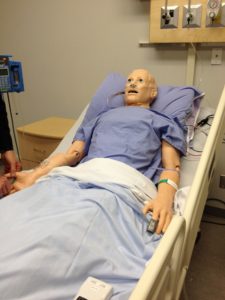“The reason why it was published in the form of a micro sub meson electronic component is that if it were printed in normal book form, an interstellar hitchhiker would require several inconveniently large buildings to carry it around in.”– The Hitchhiker’s Guide to the Galaxy
Welcome back to the second blog post of this three-part journey in simulation-based education! Today we are talking about the delivery of scenarios and debriefing, which are both huge subjects! There is heaps of literature written about these topics, maybe even enough to fill several large buildings. Thankfully, Dr Victoria Brazil is still here as our guide and she is going to give us her essential tips for delivering scenarios and debriefing.
To begin, let’s pretending that that we are delivering a scenario today. What preparation needs to be done before we start?
Just like the team participating – the people delivering the simulation need to be a team. Clarify roles – technical delivery, debriefing, and “confederates” who might be actually in the scenario to help the flow.
Test all the simulation and clinical equipment, run through your scenario again, and consider anything the participants might do that you haven’t anticipated. If you are using audio visual equipment to either record the simulation or to display it somewhere else for learners, make sure you’ve got that ready.
A lot of careful planning is required to make sure the scenario runs smoothly and that the environment is as realistic as possible!
How do you like to involve students in simulations?
This depends on the skills of the student and the skill mix of the rest of the team. Those more ‘tech-savvy’ can often assist in audiovisual role or assisting with running the sim. Many students are good to play confederates eg family members or others who help make the sim more realistic. Debriefing is probably the skill most difficult for students, as it requires a lot of practice, and often quite a lot of clinical knowledge.
Okay it’s nearly time to start and the participants are arriving! How can we introduce them to simulations?
Psychological safety is important for any simulation. This is not to say the learning experience needs to be ‘soft’, but rather than high expectations will also come with high support.
Pre-briefing is important for this – acknowledge that simulation can be anxiety provoking, clarify what will happen in the scenario and the expectations of the learners, explain what will happen in the debrief, and express respect for the effort of learners.
In some cases it’s necessary to do a familiarization to the environment in which the team will be working, depending on the scenario and how unfamiliar it is to participants.
The participants just finished their scenario and now it’s time to debrief. Can you explain a little bit about what debriefing is? And what are your top tips for effective debriefing?
It’s important to
- Have a structure, and
- Ask good questions that explore the learner performance
To maintain consistency across our debriefing team – we tend to follow the PEARLs article debriefing structure, but with some flexibility.
When participants come back into the room I will usually explain what we’re going to do – “We’re going to start our debrief. We’ll start getting a few reactions, then I’ll run through the facts of the case and then we will pick out some points which we want to focus on in analyzing what happened here and how we can continue to improve.”
So then I go into the reactions. So I say something like “How was that? How did that go? Are there any initial reactions?” And I usually leave it pretty open and let anyone talk who wants to. Obviously with more eye contact towards the people who are actually in that scenario.
I then run through the ‘facts of the case’ and I do this quickly and succinctly to ensure participants are clear on the scenario. As an example – “So just so we’re on the same page, I’ll run through the facts of the case. This was a 55-year-old man that came in with chest pain that sounded quite typical of acute coronary syndrome. He had an ECG that then showed an ST-elevation MI and we went through the process of explaining to him what had happened and then arranging his transfer to the cath lab. Is that what everyone else thought happened?”
And then I go through an analysis phase. That can be in a variety of different structures. I tend to outline what the topics are going to be and then explore why people did what they did. We discuss people’s underlying assumptions or knowledge underpinning their behaviours, rather that necessarily trying to merely correct behaviours.
This may be technical information. For example, “what is the treatment for alcohol withdrawal?” And I do that very succinctly and sometimes I offer teaching points within the debrief.
Then there are more tricky concepts like recognizing changes in patients. So that might be something along the lines of “the patient rhythm changed, how did that change things for you?” This allows people to really understand what they saw, what they did in response and why they did what they did. That can then trigger some nice discussions.
The even more difficult topics to discuss are role allocation, communication between team members and leadership. I think these sorts of topics really lend themselves to an “advocacy enquiry” type approach where you say what you observed, you give a judgment of that and you seek to explore performance gaps.
As we finish up, I usually say something along the lines of “we’re going to finish up soon, are there any other topics that people would really like to cover?” And after we’ve done that I usually ask each participant for a take home point that they have learned.
SimMan looks a bit shocked, but he tells me that the scenario went very well!
So, where to from here?
This has been a very brief overview of topics that I have spent the last 14 years trying to master or at least learn more about! There is lots to learn about simulation.
I would suggest that anyone who’s interested should look for a training experience in simulation. This could be as a student attachment, as a simulation fellow or registrar, or – if you’re a more experienced practitioner – getting a part time job with a simulation service or program.
I think you will accelerate your learning by simply being part of a simulation team, and being able to reflect on it with others who are involved. There are some resources online, our own Simulcast podcast and blog (www.simulationpodcast.com or Simulcast on iTunes), the debrief to learn podcast and blog (www.debrief2learn.com) and a variety of simulation and medical education conferences that I would recommend.
Thanks for being our awesome guide Dr Brazil! You’ve given us a great introduction into the universe of simulation-based healthcare education and some fantastic advice on how to get involved. In our next blog post we will be chatting to a junior doctor who was part of the sim delivery team as a medical student. Meanwhile, check out some of the resources below!
Resources:
- Establishing a safe container for learning in simulation. https://www.researchgate.net/profile/Robert_Simon10/publication/265343622_Establishing_a_Safe_Container_for_Learning_in_Simulation_The_Role_of_the_Presimulation_Briefing/links/5632bdbb08aefa44c3685916/Establishing-a-Safe-Container-for-Learning-in-Simulation-The-Role-of-the-Presimulation-Briefing.pdf?origin=publication_detail
- Also have a listen to the Simulcast podcast: Episode 4 http://simulationpodcast.com/2016/10/14/ep-4-safe-container-simulation/)
- PEARLs article (scripted debriefing tool) http://www.med.wisc.edu/files/smph/docs/clinical_simulation_program/promoting-excellence-and-reflective-learning.pdf
- Also have a listen to the Simulcast podcast: Episode 2 http://simulationpodcast.com/2016/08/17/eppich-debriefing/)
Written by Arielle Tay


